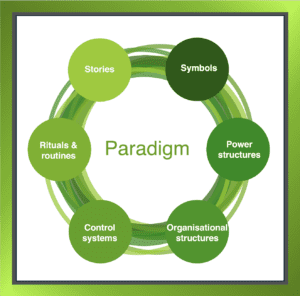Using the Johnson and Scholes Cultural Web Model
The Johnson and Scholes Cultural Web Model, developed in 1992 by academics Kevan Scholes and Gerry Johnson, serves as a fundamental tool for examining and transforming an organisation’s culture. This model aids in analysing current cultural practices and beliefs, aligning them with the desired company culture and strategic objectives.

The Cultural Web Model provides a framework to analyse and transform your organisation’s culture by examining six vital elements.
It highlights six key elements that provide a comprehensive understanding of organisational culture.
The Six Elements of the Cultural Web:
- Stories: These are the narratives about the organisation, both historical and current, that shape its identity and reputation. Consider what stories are shared with new employees and what these reveal about the company culture.
- Symbols: Visual elements like logos, office design, and dress codes reflect the organisation’s external image and internal identity. Assess how these symbols are perceived by employees and the public.
- Power Structures: Understanding who holds decision-making power within an organisation is crucial. This can include individual executives, teams, or departments that significantly influence the company’s direction and strategy.
- Organisational Structure: This involves both the formal organisational chart and informal networks of influence and authority. Examine how hierarchical and distributed responsibilities are within the organisation.
- Control Systems: These are the mechanisms for regulating organisational activities, including financial controls, quality systems, and reward structures. Analyse how processes are monitored and employees incentivised.
- Rituals and Routines: Daily activities and behaviours set the tone for what is deemed acceptable within the organisation. Evaluate what routines are integral to the organisation’s beliefs and how they are experienced by employees and customers.
By dissecting these elements, leaders can obtain a holistic view of their organisational culture. This understanding is critical for managers, as culture directly influences strategies and performance.
The Role of Managers in Cultural Transformation:
Managers play an essential role in interpreting and reshaping an organisation’s culture. They must continuously embody and communicate the cultural values through formal and informal events and feedback, ensuring every team member feels valued and aligned with organisational objectives.
To effectively alter a maladaptive culture, managers need to address structural and procedural aspects frequently.
Strategies for Cultural Change:
- Clearly define and communicate organisational goals regularly.
- Align team efforts with these goals and hold members accountable for their contributions.
- Streamline initiatives to focus on key priorities, eliminating those that do not support core objectives.
- Encourage a culture of openness by acknowledging mistakes and celebrating successes.
- Promote talent from within to reinforce desired cultural values and practices.
Advantages and Challenges of the Cultural Web Model:
The Cultural Web Model provides a thorough analysis of organisational culture and highlights strategic areas for improvement. It can guide the development of a roadmap for positive cultural changes. However, implementing this model can be time-intensive and may require objective assessment and experienced interpretation of data.
For organisations aiming to analyse and transform their culture, the Cultural Web Model offers a structured approach. If you’re interested in exploring this model further or seeking ways to enhance your organisation’s culture, contact Tick HR Solutions for expert guidance.
